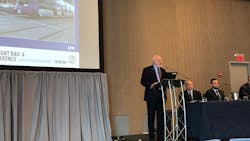The 14th National Light Rail & Streetcar Conference, jointly hosted by the American Public Transportation Association (APTA) and Transportation Research Board (TRB) and held April 7-9 in Jersey City, NJ, focused on a theme of “resurgence and renewal” by celebrating how far the transportation modes have come in 40 years and what is being done to ensure they remain viable travel options into the future.
Thomas Furmaniak, chair of the Light Rail Technical Forum, chair of the conference’s planning committee and senior director, LTK Engineering Services, kicked off the opening general session by providing a look back at the how far light-rail and streetcar systems have come since the 1970s. He noted the 800 route miles of light-rail that has been added in the past four decades and the 19 new streetcar lines that have opened since 2000 in his assessment that the “future looks bright.”
New Jersey Transit Executive Director Kevin Corbett also provided a welcome to attendees. He said NJ Transit provides 80,000 daily trips across its three light-rail lines and noted the Hudson-Bergen Light Rail Line was a key element in the growth of the conferences host locale, Jersey City.
Corbett also noted that as light-rail and streetcar systems consider expansions, the project should not be transportation for the sake of transportation, but should underpin economic development. NJ Transit has a planned expansion of Hudson-Bergen Light Rail Line north to Bergen County. Corbett recognized the project’s challenges, but said the benefits far outweigh those challenges.
APTA President and CEO Paul Skoutelas shared that in 2017, light-rail and streetcar systems carried 555 million passengers. He said jurisdictions are recognizing the benefits of light-rail and cited the recent ballot measures approved in the Florida counties of Broward and Hillsborough, which will help light-rail systems.
The conference featured discussion tracks on land use, transformational technologies, improving operations, rolling stock, state of good repair, infrastructure challenges, international light-rail and streetcar lessons learned, planning and policy, safety and a tour of the Hudson-Bergen Light Rail facilities.
The conference also featured a keynote lunch address from New York City Transit President Andy Byford, who shared with the crowd that his reputation as a turnaround expert was developed “by accident,” but noted that he does enjoy a challenge.
Byford described his prime challenges encountered during his career and how he overcame and solved those challenges. His time as COO of RailCorp in Sydney, Australia, was spent developing a customer service ethos within the company before he moved to the Toronto Transit Commission to serve as CEO where he worked to develop a top to bottom plan to modernize the system. His efforts at NYCT are and will continue to be focused on investment in the system. He believes NYCT can be completely transformed in 10 years and he has plan and a team to help him accomplish the task.
Byford’s speech and the conference’s theme both tied-in to a thought Skoutelas shared with attendees on during the opening general session: Under investment, if it goes for too long, is hard to recover from and in the age of mobility where people have choices in how they travel, service, such as that offered by light-rail and streetcar systems must be reliable.
About the Author

Mischa Wanek-Libman
Group Editorial Director
Mischa Wanek-Libman is director of communications with Transdev North America. She has more than 20 years of experience working in the transportation industry covering construction projects, engineering challenges, transit and rail operations and best practices.
Wanek-Libman has held top editorial positions at freight rail and public transportation business-to-business publications including as editor-in-chief and editorial director of Mass Transit from 2018-2024. She has been recognized for editorial excellence through her individual work, as well as for collaborative content.
She is an active member of the American Public Transportation Association's Marketing and Communications Committee and served 14 years as a Board Observer on the National Railroad Construction and Maintenance Association (NRC) Board of Directors.
She is a graduate of Drake University in Des Moines, Iowa, where she earned a Bachelor of Arts degree in Journalism and Mass Communication.
